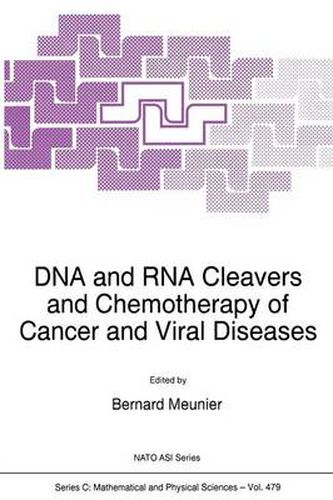Readings Newsletter
Become a Readings Member to make your shopping experience even easier.
Sign in or sign up for free!
You’re not far away from qualifying for FREE standard shipping within Australia
You’ve qualified for FREE standard shipping within Australia
The cart is loading…






This title is printed to order. This book may have been self-published. If so, we cannot guarantee the quality of the content. In the main most books will have gone through the editing process however some may not. We therefore suggest that you be aware of this before ordering this book. If in doubt check either the author or publisher’s details as we are unable to accept any returns unless they are faulty. Please contact us if you have any questions.
The past decade has witnessed a burst of activity and interest in the discovery and design of drugs that cleave DNA and RNA with sequence specificity. This interest stems from the potential of this class of compounds to be useful as therapeutics agents, in particular in the field of the treatment of cancer and viral diseases. Further, a side benefit of such studies is the discovery of novel mechanisms and uses of such agents as tools in the study of structure and function of nucleic acids. Up to now, no international meeting has been organized to recognize the immense progress that has been made in this field. The field of DNA and RNA cleavage by natural and chemical drugs now includes researchers working with rather dissimilar agents but with common underlying mechanisms of DNA damage. Until recently, these scientists were working in separate, apparently unrelated areas, such as the enediyne antibiotics and their synthetic analogues, bleomycin-metal complexes, metal-drug complexes, ribozymes and ribozyme mimics, and antisense and antigene oligonucleotides, etc. It is now clear that these research areas have in common strategies and targets. Researchers representing these areas worked together at this workshop where these common interests were discussed and scientific ideas modified and criticized. Such a workshop should lead to new research approaches and collaborative interactions, and is expected to significantly enhance the progress in the field of DNA and RNA cleavage.
$9.00 standard shipping within Australia
FREE standard shipping within Australia for orders over $100.00
Express & International shipping calculated at checkout
This title is printed to order. This book may have been self-published. If so, we cannot guarantee the quality of the content. In the main most books will have gone through the editing process however some may not. We therefore suggest that you be aware of this before ordering this book. If in doubt check either the author or publisher’s details as we are unable to accept any returns unless they are faulty. Please contact us if you have any questions.
The past decade has witnessed a burst of activity and interest in the discovery and design of drugs that cleave DNA and RNA with sequence specificity. This interest stems from the potential of this class of compounds to be useful as therapeutics agents, in particular in the field of the treatment of cancer and viral diseases. Further, a side benefit of such studies is the discovery of novel mechanisms and uses of such agents as tools in the study of structure and function of nucleic acids. Up to now, no international meeting has been organized to recognize the immense progress that has been made in this field. The field of DNA and RNA cleavage by natural and chemical drugs now includes researchers working with rather dissimilar agents but with common underlying mechanisms of DNA damage. Until recently, these scientists were working in separate, apparently unrelated areas, such as the enediyne antibiotics and their synthetic analogues, bleomycin-metal complexes, metal-drug complexes, ribozymes and ribozyme mimics, and antisense and antigene oligonucleotides, etc. It is now clear that these research areas have in common strategies and targets. Researchers representing these areas worked together at this workshop where these common interests were discussed and scientific ideas modified and criticized. Such a workshop should lead to new research approaches and collaborative interactions, and is expected to significantly enhance the progress in the field of DNA and RNA cleavage.